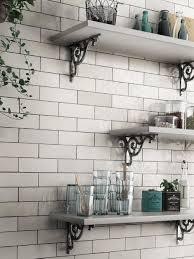
There are several! Subway tiles have long been a popular option for contemporary bathrooms due to their incredible versatility in terms of shapes, colors, and patterns. They look great and provide an air of sophistication to your bathroom, giving it a strong sense of individuality. They are contemporary and reasonably priced. Additionally, washing these subway tiles is not necessarily a hazard……unless you neglect your bathroom (no offense).
Have you made up your mind to purchase these tiles for your bathroom? Then you’d be wise to pause for a while. This is because you risk entirely ruining the effect you envisioned if these tiles are not properly cared for throughout the installation procedure.
This blog will provide you with valuable information on what specialists perform throughout such a job.
Continue reading to learn more.
1. Professionals Maintain a Ledger
The majority of professionals would never consider laying subway tiles without a ledger. The truth is, that subway tiles have a very distinct boundary, which is regarded as a critical component of their magnificence. Without a substance for the ledger, the alignment may be bent. It causes significant irritation to the eye. Additionally, it may weaken the tiles’ hold on the wall. A thorough subway tile bathroom restoration in the north of the river Perth will need a supporting wooden piece between the initial rows of tiles. This stage informs the professionals about the precise alignment that should be used. Additionally, the whole procedure becomes much simpler.
2. At Times, a Tile Cutter Is Required
While the tile cutter may not seem to be a serious instrument, its use is really serious. There are several tile cutters available, and you may be unsure which one you need for subway tiles alone. Additionally, a little error in their use might result in an accident and irreversibly destroy a subway tile.
3. Inspecting the Spacers: The Spacers Are Found on the Majority of Subway Tiles

Failure to provide the appropriate spacers might be a significant blunder. This factor, however, may be used to other types of tiles but not to subway tiles (at least not with most of them). What specialists do is inspect the tiles for those spacers and apply them only if a very thick grout line is required. Generally, you do not need such thicker looks at the grout around your subway tiles in Perth when renovating your bathroom. It does not look nice and will get dirtier with time.
4. It’s Almost Time for the Edges!
In most circumstances, the margins of these tiles might detract from their appearance if they are not correctly edged. Pros are responsible for measuring the tiles and ensuring that they are consistent with the boundaries of the walls. They make further efforts if the anticipated results do not occur as a result of the tile measurement and the available space at the walls.
5. Constant Cleaning
The professionals understand that the binding ingredient will continue to withdraw from the grouts the harder the tiles are forced to adhere to the surface of the walls. If they do not continue cleaning the additional residue being retrieved, it may get trapped as it dries.
The following are some fascinating facts regarding subway tiles.
We’ve alleviated some of the tension by compiling some interesting facts about subway tiles. You probably had no idea what you were about to learn. Okay, here we go:
It is also available in glass and stone.
And if you believed subway tile could be characterized only by its manufacturing process, think again. A thin, low-fired, glazed ceramic tile is the official definition. However, the Washington Post reports that the very first prototypes in the New York City subway were constructed entirely of white glass. Nowadays, “subway tiles” are made of a variety of materials, including glass, stone, and marble. Visit http://nosdrift.com/a-personal-experience-of-subway-tiles-installation/ to read about A personal experience of subway tiles installation.
It may cost less than a dollar.
The cost of subway tile varies significantly. Simple, hardware-store versions, such as the Daltile Ceramic Bullnose Wall Tile from Home Depot, may cost as little as $1 per tile (or $8 per square foot); whereas handcrafted, artisan renditions, such as those from Heath Ceramics, can cost upwards of $60 per square foot.
Grout is critical.
Grouting may be an afterthought after all the work (and price) that goes into obtaining tile. However, this should not be the case: the grout you pick may radically alter the appearance and design of your subway tiles.
The options for pattern creation are limitless.
You’re probably visualizing subway tile arranged horizontally in the traditional “brick” design. However, did you know that subway tile may be laid vertically—or even in herringbone or geometric L-shaped patterns?
It is not intended for use on flooring.
What is the one spot where subway tile should not be used? On the floor. Subway tiles, being relatively thin, will not withstand wear and tear.
It’s the equivalent of a well-fitting pair of jeans in terms of design.
“It’s become a staple, like jeans and a T-shirt,” Deborah Osburn, proprietor of Clé Tile in California, said. Consider subway tile to be classic, practical clothing essential that pairs well with almost everything. “Even the cheapest tile can be dressed up or down to make a style statement,” Osburn explains.
Why are they referred to as subway tiles?
You may be asking why subway tiles are referred to as subway tiles. The response is: They were first installed at New York City subway stations.
Subway tiles were established in 1904 when designers were entrusted with creating a surface that was both low-maintenance and colorful for the first subway station.
Victorians placed a premium on cleanliness, which is why easy-to-clean, stain-resistant, and bacteria-resistant ceramic tile was an obvious option. Additionally, the white and glossy style of the initial subway tiles created a highly reflecting surface that contributed to the creation of a safe, hygienic sense for passengers who may have been concerned about subterranean transit.
Is Subway Tile Still in Fashion?
Subway tiling was introduced in 1904 and quickly spread to other transit centers across the globe. Due to its cleanliness look and health advantages, it was quickly adopted for usage in areas where hygiene was a priority, such as kitchens and baths.
Today, subway tile continues to gain popularity.
We are often asked whether subway tile is a trend. While the great popularity of this tile pattern may lead you to believe it is a passing fad, its persistence is a strong indication that this is not the case. Over a century old, subway tile continues to be a popular choice for homeowners and business owners alike. You can read about Insure Your Business by clicking here.
So, what is it about subway tile that makes it so popular?
We must attribute this to the subway tile design’s intrinsic timelessness. Subway tile has created a look that is both striking and simple to accomplish by using basic white rectangular tiles and a simple tile configuration.

